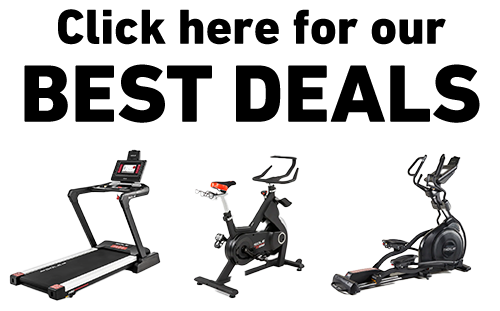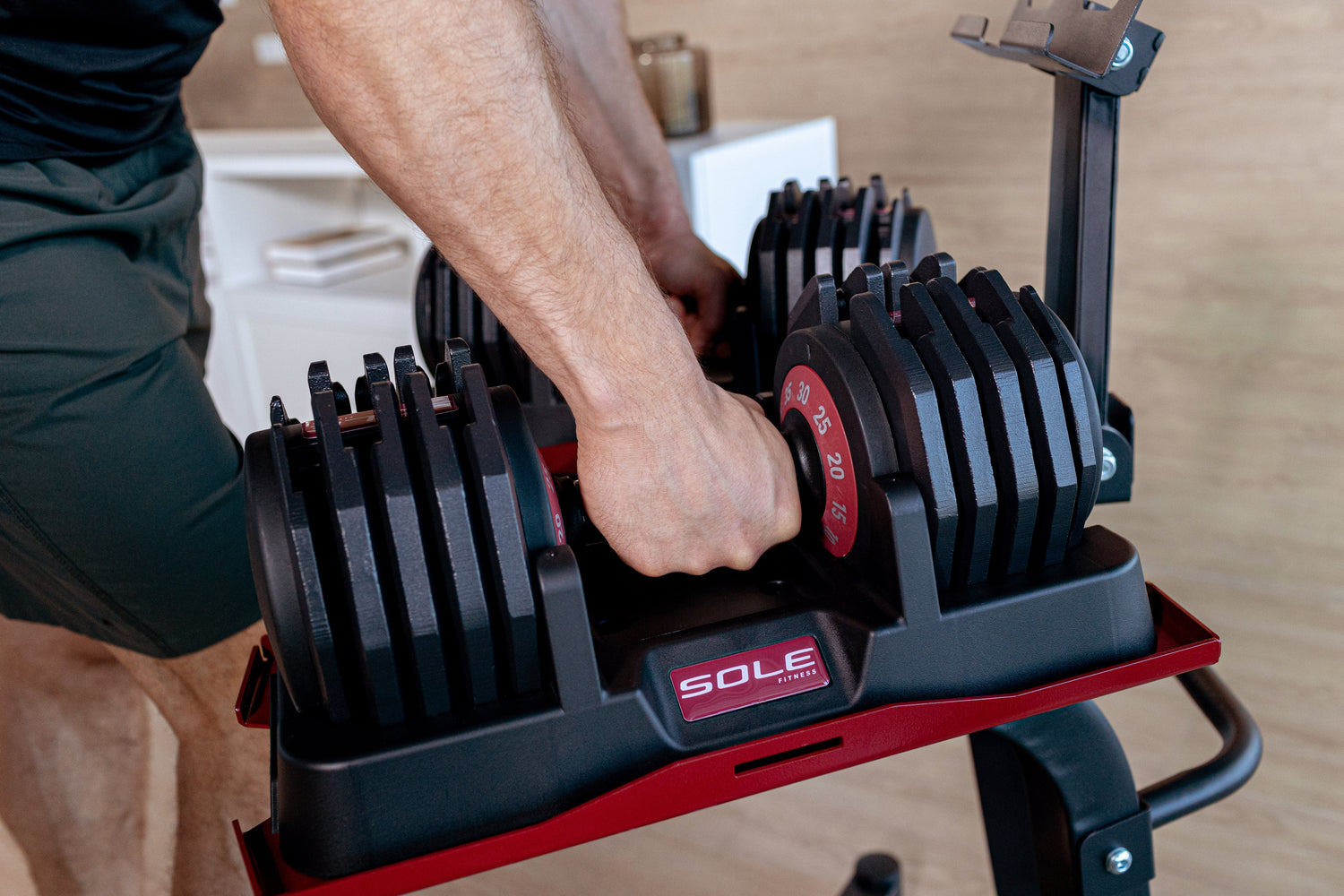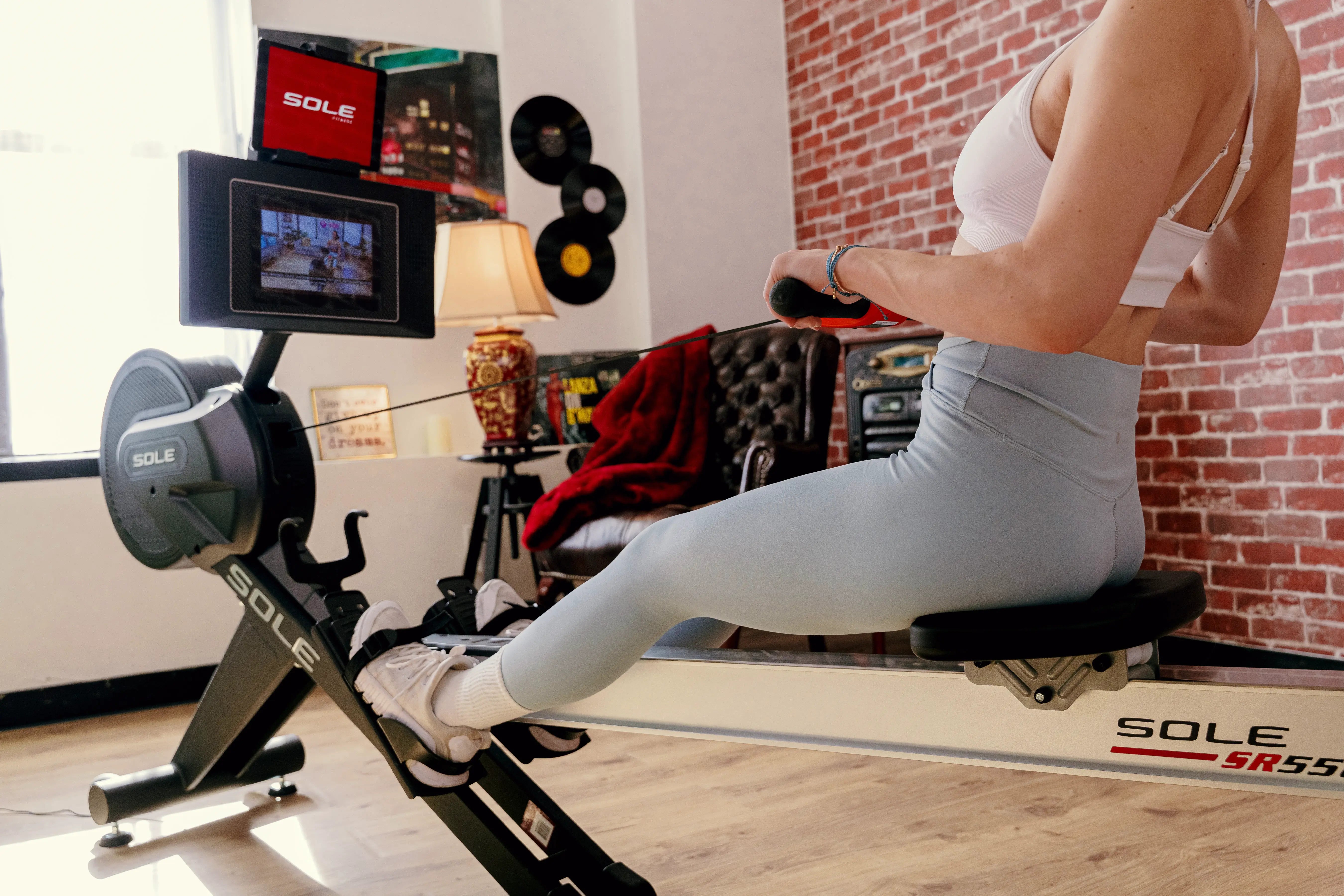Key Takeaways
- Dumbbell workouts effectively target all major leg muscles while requiring minimal equipment and space.
- Progressive overload is possible with dumbbells through advanced techniques like tempo training and unilateral movements.
- Unilateral training with dumbbells corrects muscle imbalances while enhancing core stability and functional strength.
- The hypertrophy-focused workout delivers maximum muscle growth through strategic exercise selection and rep ranges.
- SOLE's adjustable dumbbells provide the precision and versatility needed for optimal lower body development.
Why Dumbbells Are Perfect for Lower Body Training
Looking to build strong, shapely legs without fancy gym equipment? Dumbbell workouts might be exactly what you need. With just a pair of dumbbells, you can target every muscle in your lower body through strategic exercise selection and proper programming.
While barbells might get all the glory in the strength training world, dumbbells offer unique advantages that make them exceptional tools for building impressive legs.
The unilateral nature of dumbbell training helps correct muscle imbalances that often go unaddressed with traditional barbell exercises. This means more symmetrical development and reduced injury risk over time.
Space-Efficient Alternative to Gym Equipment
The beauty of dumbbell training lies in its simplicity. You don't need a power rack, platform, or specialized machines to get an effective leg workout.
A pair of adjustable dumbbells can replace an entire gym's worth of lower body equipment, making them perfect for home gyms or small spaces. Even in a well-equipped commercial gym, dumbbells allow you to claim a small corner and complete your entire workout without waiting for equipment.
Versatility for Targeting Multiple Muscle Groups
Dumbbells allow for movements in multiple planes of motion, which better mimic real-world movement patterns. Unlike fixed machines that lock you into predetermined paths, dumbbells require your body to stabilize and control the weight throughout the entire range of motion.
This versatility means you can hit your quads, hamstrings, glutes, and calves from various angles with just a simple weight change or position adjustment.
The freedom of movement with dumbbells also allows for more exercise variations. You can easily transition from a goblet squat to a lunge to a Romanian deadlift without changing equipment. This flow creates more efficient workouts and keeps your heart rate elevated for additional cardiovascular benefits.
Enhanced Stability and Core Engagement
Every dumbbell leg exercise doubles as a core workout. The need to stabilize uneven loads forces your core muscles to work overtime, creating a stronger foundation for all movement. This increased stabilization requirement builds functional strength that transfers to everyday activities and athletic performance. Your body learns to coordinate multiple muscle groups simultaneously, improving overall movement quality.
For beginners, dumbbells are less intimidating than loaded barbells while still providing progressive resistance. For advanced lifters, they offer novel stimuli that can break through plateaus.
|
Build Your Foundation with Premium-Grade Strength Equipment!
 Complete Your Home Gym:
Why Choose SOLE Strength: ✓ Heavy-duty steel construction with rust protection 30-Day Money-Back Guarantee: Love it or return it, no questions asked. |
Workout #1: 20-Minute Beginner Leg Builder

This time-efficient beginner workout focuses on fundamental movement patterns while building strength through the squat, hinge, and lunge patterns with proper progression.
Goblet Squats: Master Perfect Form
The goblet squat serves as the ideal squat variation for beginners due to its forgiving nature and natural promotion of proper form. Hold a single dumbbell vertically against your chest, with your elbows pointing downward.
Stand with feet slightly wider than shoulder-width, toes turned slightly outward. Inhale as you send your hips back and down, keeping your chest tall and knees tracking over your toes.
Descend until your thighs are parallel to the ground (or as deep as mobility allows), then exhale as you drive through your heels to return to standing. The front-loaded position naturally improves posture and depth while activating the core. Perform 3 sets of 10–12 reps.
Romanian Deadlifts for Hamstring Development
The Romanian deadlift targets the entire posterior chain—hamstrings, glutes, and lower back. Hold the dumbbells in front of your thighs with palms facing your body.
Maintain a slight bend in your knees throughout the movement. Hinge at the hips by pushing your buttocks backward while keeping your back flat and shoulders retracted.
Lower the weights along your legs until you feel a stretch in your hamstrings (typically just below the knees), then squeeze your glutes to return to the starting position. Focus on the hip hinge pattern rather than squatting down. Perform 3 sets of 10 reps.
Dumbbell Step-Ups for Single-Leg Strength
Step-ups build unilateral leg strength while improving balance and coordination. Select a bench or platform approximately 12–18 inches high. Hold dumbbells at your sides with palms facing inward.
Place your entire right foot on the platform, push through the heel to straighten your right leg, and bring your left foot up next to it.
Step down with the left foot first, followed by the right. The key is driving through the heel of the working leg rather than pushing off with the floor foot. Perform 3 sets of 8 reps per leg.
Complete 20-Minute Beginner Workout:
- Goblet Squats: 10–12 reps
- Romanian Deadlifts: 10 reps
- Dumbbell Step-Ups: 8 reps per leg
- Rest 90 seconds between rounds
- Complete 3 total rounds
Workout #2: Hypertrophy-Focused Quad and Glute Blaster

This muscle-building routine uses higher repetition ranges and strategic exercise selection to maximize time under tension for optimal hypertrophy stimulus.
Bulgarian Split Squats for Muscle Growth
Bulgarian split squats are unparalleled for quad development while simultaneously engaging the glutes and hamstrings. Stand about two feet in front of a bench, holding dumbbells at your sides. Place the top of your right foot on the bench behind you. Lower your body by bending your front knee until your thigh is parallel to the ground, ensuring your knee tracks over your toes.
Push through the heel of your front foot to return to the starting position. Complete all reps on one leg before switching sides. Perform 3 sets of 10–12 reps per leg.
Alternating Side Lunges for Inner Thigh Activation
Side lunges target the often-neglected adductors (inner thighs) while also working the quads and glutes from a different angle. Stand with your feet together, holding dumbbells at your sides. Take a wide step to the right, keeping your left leg straight as you bend your right knee and lower your hips back and down.
Push through the right heel to return to the starting position, then repeat on the opposite side. Perform 3 sets of 8–10 reps per side.
Sumo Squats for Maximum Glute Engagement
The wide stance of sumo squats shifts emphasis to the inner thighs, glutes, and hamstrings. Stand with feet wider than shoulder-width and toes turned out at approximately 45 degrees. Hold a heavy dumbbell vertically between your legs. Keep your chest up and core braced as you push your hips back and bend your knees to lower into a deep squat.
Descend until your thighs are at least parallel to the floor, then drive through your heels to return to standing, squeezing your glutes at the top. Perform 3 sets of 12–15 reps.
Dumbbell Hip Thrusts for Posterior Chain Development
Hip thrusts are the gold standard for glute development. Sit on the floor with your upper back against a bench, knees bent, and feet flat. Place a dumbbell across your hips. Engage your core and press through your heels to lift your hips until your body forms a straight line from shoulders to knees.
Squeeze your glutes at the top for 1–2 seconds before lowering with control. Focus on using your glutes rather than your lower back to power the movement. Perform 3 sets of 12–15 reps.
Rest Guidelines: 60–90 seconds between sets. Select weights that make the last 2–3 reps challenging but achievable with proper form.
Workout #3: Advanced Full-Leg Power Circuit

This advanced circuit combines strength, power, and endurance through explosive movements and unilateral challenges for comprehensive athletic development.
Single-Leg Romanian Deadlifts for Balance and Strength
The single-leg Romanian deadlift challenges balance, coordination, and posterior chain strength simultaneously. Stand on your right leg, holding dumbbells at your sides. With a slight bend in your right knee, hinge at the hips while extending your left leg behind you in line with your torso.
Lower the weights toward the floor while maintaining a flat back until you feel a stretch in your right hamstring. Drive through your right heel to return to standing. Perform 3 sets of 8 reps per leg.
Walking Lunges with Overhead Press for Full-Body Integration.
Walking lunges with overhead press create a total-body exercise that challenges your cardiovascular system while building lower body strength. Hold dumbbells at shoulder height. Step forward with your right foot into a lunge position, lowering until both knees form 90-degree angles.
As you push through your right heel to stand, simultaneously press the dumbbells overhead. Step directly into the next lunge with your left foot while lowering the weights back to your shoulders. Perform 3 sets of 10 steps forward per leg.
Dumbbell Jump Squats for Explosive Power
Jump squats develop explosive power throughout the entire lower body. Hold light to moderate dumbbells at your sides with feet shoulder-width apart. Lower into a quarter squat position. From this loaded position, explosively jump upward by extending your hips, knees, and ankles.
Land softly by absorbing the impact through your legs, immediately lowering back into the squat position. The key is controlling the landing phase and using weights lighter than regular squats. Perform 3 sets of 8–10 repetitions.
Circuit Structure: Perform exercises back-to-back with minimal rest, then rest 90–120 seconds between rounds. Complete 3–4 total rounds.
Master Lower Body Training with SOLE's Precision Dumbbells

SOLE's adjustable dumbbells transform lower body training by providing precise weight progression from beginner goblet squats to advanced single-leg movements.
SOLE's SW180 Adjustable Dumbbells provide everything needed for these three comprehensive workouts.
With 16 weight options from 5–80 pounds, you can progress seamlessly from the beginner goblet squats at 15 pounds to advanced Bulgarian split squats at 40+ pounds per hand.
The quick-adjust dial system means effortless transitions between exercises—crucial for the hypertrophy circuit where you might use 30 pounds for sumo squats, then quickly drop to 20 pounds for hip thrusts. No more interrupting your workout flow to hunt for different weights or waiting for equipment at crowded gyms.
The SW155 Adjustable Dumbbells offer an excellent entry point for beginners, providing 10-55 pounds per dumbbell, perfect for mastering the fundamental movement patterns before progressing to heavier loads.
Both models feature balanced weight distribution that feels natural during unilateral exercises like single-leg Romanian deadlifts.
Add the SW116 Weight Bench for Bulgarian split squats and hip thrusts, plus the Equipment Mat for floor exercises and joint protection. The SOLE+ App provides guided dumbbell workouts with form tutorials and progression tracking to ensure continuous improvement.
Ready to build powerful legs with equipment that grows with you? Shop our strength equipment today!
Frequently Asked Questions (FAQs)
How often should I do these dumbbell leg workouts per week?
Train legs 2–3 times per week with at least 48 hours between sessions for proper recovery. Beginners should start with two weekly sessions of the beginner workout, while intermediate lifters can rotate between all three workouts throughout the week.
Can I build significant muscle with just dumbbells?
Yes! Dumbbells create significant muscle growth through stabilization demands, greater range of motion, and unilateral training that prevents imbalances. The key is progressive overload - consistently challenging muscles through increased weight, volume, or improved execution.
How do I modify these workouts if I have knee pain?
Reduce range of motion in squatting movements, emphasize posterior chain exercises like Romanian deadlifts, replace jump squats with controlled movements, and use lighter weights with higher reps. Always consult healthcare providers for persistent pain.
Should I still do cardio on leg training days?
If building strength is your priority, do leg training first, followed by 15-20 minutes of low-impact cardio. For fat loss, consider replacing traditional cardio with workout finishers. The advanced power circuit already provides significant cardiovascular benefits.
What weight dumbbells should beginners start with for leg exercises?
Women typically start with 8–15 pound dumbbells, while men begin with 15–25 pounds. Choose weights that make the last 2–3 reps challenging but achievable with perfect form. SOLE's adjustable dumbbells allow precise progression as you get stronger.







Leave a comment
This site is protected by hCaptcha and the hCaptcha Privacy Policy and Terms of Service apply.